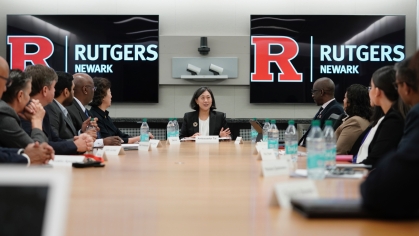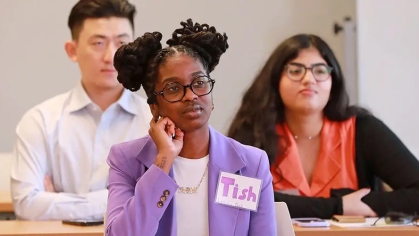Students studying supply chain and fashion carry out class project in style
Students in Rutgers Business School’s new course “Supply Chain Management for Fashion and Other Creative Pursuits” capped off their semester in style.
After months of lessons on logistics of sourcing, producing and distributing, they tackled one of the industry’s essentials: a fashion show.
"Runway to Cuba" transformed a corridor outside the Barat Foundation’s gallery in Newark’s Gateway Center into an impromptu runway, where models in sexy short sets, satiny skirts and seductive dresses strutted by as cameras flashed and Salsa pulsated.
While the students handled the details – from enlisting the designers and arranging music to designing graphics and recruiting photographers and models – a handful of fashion designers, including Montclair's Bridgett Artise and Newark’s own Marco Hall contributed pieces inspired by colorful, hot, sultry Cuba.
Monika Zabel, a designer known for using sustainable material in her collections, started off the show with a series of glamorous party dresses, long, sleeveless vests and a shrug-like evening cape. Malcolm Diggs and Kevin Wilkins, who work closely with Hall, provided a prelude to their mentor’s collection of clingy, sexy gowns and jumpsuits. Hall’s resort collection also included sophisticated rompers, a gathered sun dress and a stunning red-hooded crochet circle dress.
Supply Chain Management professor Kevin Lyons assigned the project to his students as a way of giving them a hands-on learning experience, something that would bring more meaning to months of lessons. "Supply Chain Management for Fashion and Other Creative Pursuits" is offered as part of the Business of Fashion concentration at Rutgers Business School.
During the semester, the class learned about sourcing textiles and the time lines involved in moving materials from one place in the world to manufacturers and finally, to retail stores an ocean away. They also learned the role fashion shows play in the industry.
Elizabeth Ravit, a professor in Rutgers University’s Department of Environmental Science, had a front row seat on the catwalk outside One Gallery. Before she became a professor, Ravit said she spent years working with the fashion industry through her work in retail.
"In any aspect of the fashion business, it’s about problem-solving, being able to deal with the unexpected,” Ravit said. "The challenge of making this come together,” she said, required the students to apply a lot of practical skills.
The fashion show also reflected Rutgers Business School’s efforts to forge collaborations with small business people, artists and industry in the Newark community that is identified as a priority in the new strategic plan for Rutgers University-Newark.
"When it comes to supply chain, fashion doesn’t have to be limited to Milan and Paris or even New York City, it can happen here in Newark,” Lyons said.
For the students, producing the fashion show proved to be eye-opening.
Robert Simak, a senior majoring in supply chain management, said some of the behind-the-scenes work was painstaking, testing his resourcefulness and creativity. He said he was required to negotiate and purchase materials within a budget and to work with a variety of personalities.
"It was one of the most interesting and out-of-the-box experiences I’ve had at Rutgers,” Simak said.
Lyons was counting on that.
"We can teach as much as we can teach," he said, "but when you can get experience like this, you can’t beat it."


